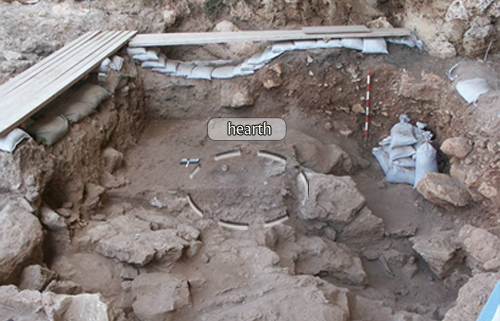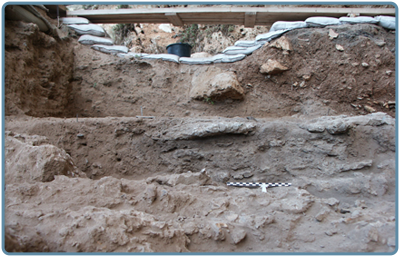

Use of fire is one of the primary hominin behaviors documented in Mousterian cave sites of the Levant. Together with lithic production and butchering the controlled use of fire is recorded in Misliya Cave as well.
The use of fire in hominin sites is known from as early as the Early Middle Pleistocene (e.g., Goren-Inbar et al. 2004). However solid evidence, including burnt lithics, bones and sediments, and well-preserved hearths appear only in the Middle Paleolithic, mainly in its later parts (e.g., the Mousterian of Tabun and Kebara caves, Garrod and Bate 1937; Albert et al. 1999; Schiegel et al. 1994; Weiner et al. 2002).
 Together with Hayonim (Weiner et al. 2002; Stiner et al., 2005), Misliya Cave provides important insights into earlier stages of Middle Paleolithic use of fire. The Early Mousterian in Misliya Cave was excavated in an area of approximately 20 sq meters. Evidence for the use of fire was found in abundance. Burnt flints and bones were exposed in varying densities in all excavated areas.
Together with Hayonim (Weiner et al. 2002; Stiner et al., 2005), Misliya Cave provides important insights into earlier stages of Middle Paleolithic use of fire. The Early Mousterian in Misliya Cave was excavated in an area of approximately 20 sq meters. Evidence for the use of fire was found in abundance. Burnt flints and bones were exposed in varying densities in all excavated areas.

 Traces of controlled use of fire are also apparent in several sections, where gray horizons appear in the breccia. These horizons, in comparison to other layers, are richer in burnt flints, bones, and preserved microscopic pieces of charcoal, and contain abundant calcite that may have derived from ashes. These are probably the remains of badly preserved hearths or fire-places.
Traces of controlled use of fire are also apparent in several sections, where gray horizons appear in the breccia. These horizons, in comparison to other layers, are richer in burnt flints, bones, and preserved microscopic pieces of charcoal, and contain abundant calcite that may have derived from ashes. These are probably the remains of badly preserved hearths or fire-places.
Some of the hearths in the breccia are relatively well preserved. One of  these, discovered during the 2005 excavation season, contains black and gray sediments (probably ashes and charcoals) which are clearly different from the brownish sediments outside the hearth.
these, discovered during the 2005 excavation season, contains black and gray sediments (probably ashes and charcoals) which are clearly different from the brownish sediments outside the hearth.
While the brecciated layers and hearths underwent intense post- depositional modifications, often masking their original features, the soft sediments preserve in situ clearly visible evidence for the use of fire. This includes "pockets" of exploded flints that remained in situ for some 200,000 years and a hearth, which is yet to be fully excavated. Its shape is probably elliptical or rounded, and it appears as a lens about 20 cm thick in section.
depositional modifications, often masking their original features, the soft sediments preserve in situ clearly visible evidence for the use of fire. This includes "pockets" of exploded flints that remained in situ for some 200,000 years and a hearth, which is yet to be fully excavated. Its shape is probably elliptical or rounded, and it appears as a lens about 20 cm thick in section.

 The hearth exhibits alternating layers of white and gray ashes with "baked" brownish and orange sediments, and contains charcoal pieces and burnt bones and artifacts.
The hearth exhibits alternating layers of white and gray ashes with "baked" brownish and orange sediments, and contains charcoal pieces and burnt bones and artifacts.
The sediments inside the hearth are easily differentiated from the surrounding ones and the hearth's contour is well-defined. It is not clear yet whether the Misliya people dug a pit for the construction of the hearth, or used a natural cavity in the ancient rock-fall that delimits the hearth from the east. Micromorphological evidence points to very good preservation of hearth features. Here, too, burnt bones and lithics occur in higher densities inside the hearth relative to the surrounding areas.
- Albert, R. M., Lavi, O., Estroff, L., Weiner, S., Tsatskin, A., Ronen, A. and Lev-Yadun, S. 1999. Mode of occupation of Tabun Cave, Mt Carmel, Israel during the Mousterian period: A study of the sediments and phytoliths. Journal of Archaeological Science 26:1249-1260.
- Garrod, D.A.E and Bate, D.M.A. 1937. The Stone Age of Mount Carmel. Vol. I., Excavations at the Wadi Mughara. Oxford, Clarendon Press.
- Goren-Inbar, N., Alperon, N., Kislev, M. E., Simchoni, O., Melamed, Y., Ben-Nun, A. and Werker, E. 2004. Evidence of hominin control of fire at Gesher Benot Ya'aqov, Israel. Science 304: 752-727.
- Schiegel, S., Lev-Yadun, S. Bar-Yosef, O., El Goresy, A. and Weiner, S. 1994. Siliceous aggregates from prehistoric wood ash: A major component of sediments in Kebara and Hayonim caves (Israel). Israel Journal of Earth Sciences 43:267-278.
- Stiner, M. C., Kuhn, S. L., Surovell, T. A. Goldberg, P., Margaris, A. V., Meignen, L., Weiner, S. and Bar-Yosef, O. 2005. Bone, Ash, and Shell Preservation in Hayonim Cave. In; Stiner, M. C. The Faunas of Hayonim Cave, Israel: A 200,000-Year Record of Paleolithic Diet, Demography, and Society. ASPR Bulletin 48, Peabody Museum of Archaeology and Ethnology, Harvard University, pp. 59-79.
- Weiner, S., Goldberg, P. and Bar-Yosef, O. 2002. Three-dimensional distribution of minerals in sediments of Hayonim Cave, Israel: Diagenetic processes and archaeological implications. Journal of Archaeological Science 29: 1289-1308.


